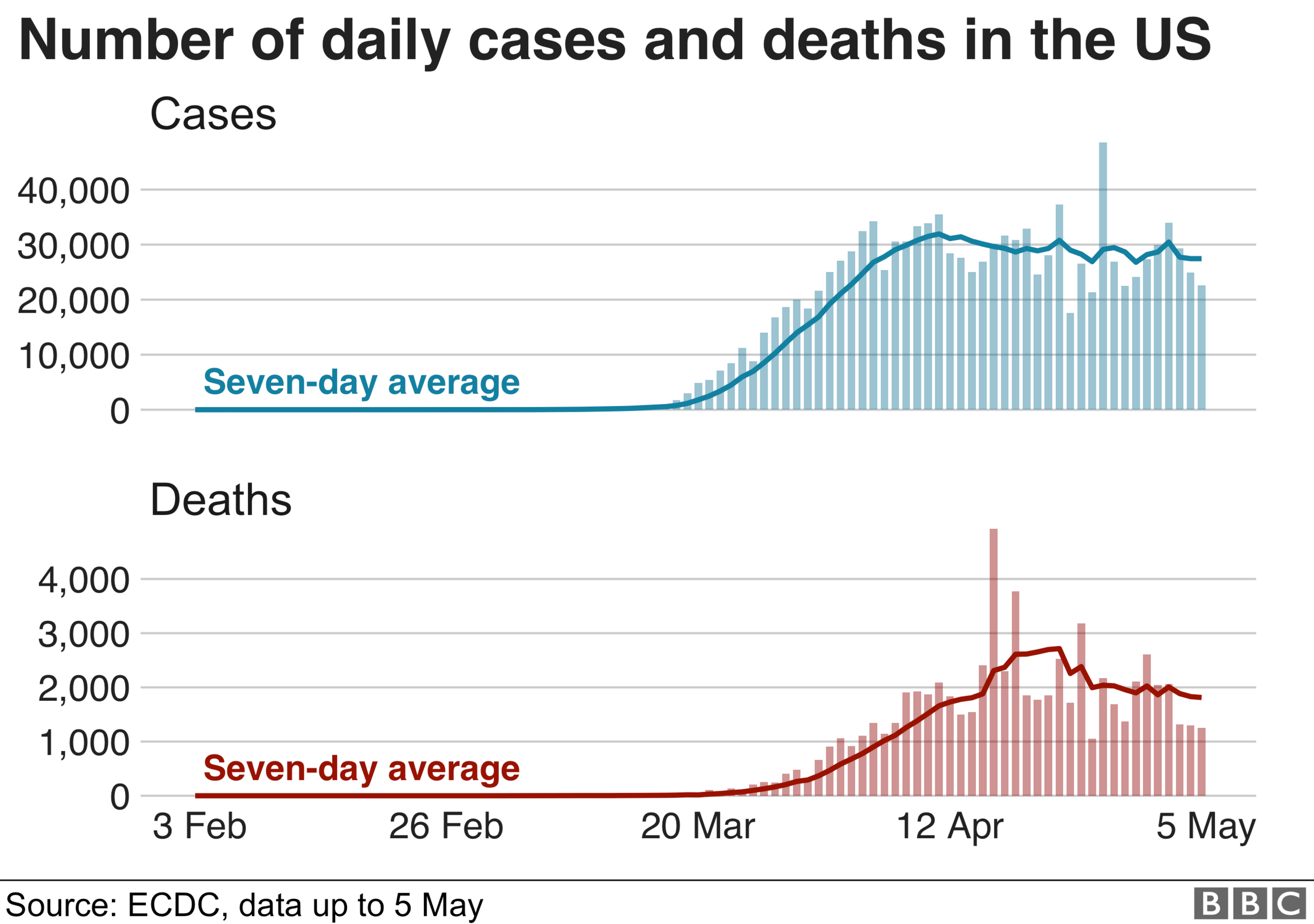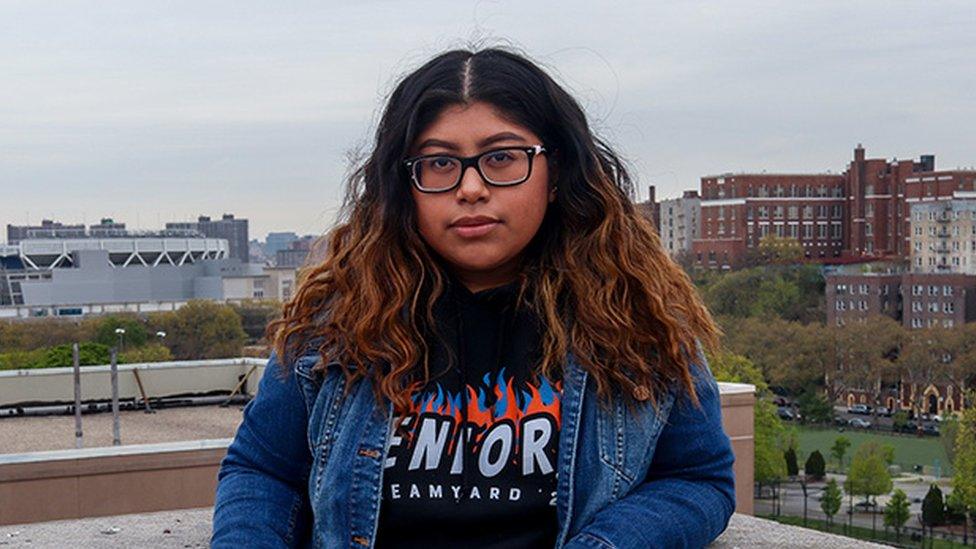Coronavirus: White House plans to disband virus task force
- Published
Trump: 'Mike Pence and the taskforce have done a great job'
US President Donald Trump has confirmed the White House coronavirus task force will be winding down, with Vice-President Mike Pence suggesting it could be disbanded within weeks.
"We are bringing our country back," Mr Trump said during a visit to a mask-manufacturing factory in Arizona.
New confirmed infections per day in the US currently top 20,000, and daily deaths exceed 1,000.
US health officials warn the virus may spread as businesses begin to reopen.
The US currently has 1.2 million confirmed coronavirus infections and more than 70,000 related deaths, according to Johns Hopkins University in Baltimore, Maryland, which is tracking the pandemic.
What did President Trump say?
During a visit to the plant in Phoenix after weeks holed up at the White House, Mr Trump told journalists: "Mike Pence and the task force have done a great job, but we're now looking at a little bit of a different form, and that form is safety and opening. And we'll have a different group probably set up for that."
Coronavirus: How long does it take to recover?
The president - who wore safety goggles but no face mask during his tour of the facility - was asked if it was "mission accomplished", and he said: "No, not at all. The mission accomplished is when it's over."
Critics have accused the president of sacrificing Americans' public health in his eagerness to reopen the US economy ahead of his re-election battle in November.
In Arizona on Tuesday, Mr Trump said that Democrats were hoping his coronavirus policy would fail "so they can win the election".
Acknowledging a human cost to the plans, Mr Trump told reporters: "I'm not saying anything is perfect, and yes, will some people be affected? Yes.
"Will some people be affected badly? Yes. But we have to get our country open and we have to get it open soon."
However, it will be up to individual states to determine how they reopen.
Some Democratic governors in badly hit states have been cautious, calling for more testing and other safeguards before easing lockdowns. Other states, many led by Republicans in the south and mid-west, have already begun lifting restrictions.
The task force was set up on 29 January. Mr Pence became its chairman four weeks later and its members include more than 20 experts and leading administration officials. The White House said the task force's duty was to "lead the administration's efforts to monitor, contain and mitigate the spread of the virus" and provide the public with information.
Mr Trump's once-daily task force briefings became increasingly scarce after he was widely condemned by the medical community for pondering at the podium last month whether injecting bleach into people might kill the virus.
Dr Deborah Birx has been the task force's response co-ordinator. The president was asked on Tuesday whether she and another high-profile member, Dr Anthony Fauci, would still be involved in efforts to address the coronavirus.
"They will be and so will other doctors and so will other experts in the field," the president said.

What did the vice-president say?
Mr Pence earlier on Tuesday told reporters in a briefing that the task force could soon be disbanded.
He said the Trump administration was "starting to look at the Memorial Day [late May] window, early June window as a time when we could begin to transition back to having our agencies begin to manage, begin to manage our national response in a more traditional manner".
He said it was "a reflection of the tremendous progress we've made as a country".
Mr Pence has led the task force, which reports to the president and co-ordinates with medical institutes, political staff and state governors. The group also consulted medical experts to formulate national guidelines on social distancing.
White House press secretary Kayleigh McEnany later tweeted that the president "will continue his data-driven approach towards safely re-opening".
Coronavirus: When might Hollywood reopen for business?


Lives and livelihoods
The White House's shift in focus from the public health aspect of the coronavirus pandemic to its economic impact continues.
For more than a month, the task force had been the public face of the administration's response to the crisis, even though President Trump sometimes veered far from the topic at hand during its press briefings.
When the president wasn't talking, however, government public health officials led the conversation.
Now, it appears, the officials setting the agenda will be ones more concerned with jobs, businesses and the fiscal health of the nation - even though the number of cases of the virus throughout the US continues to increase.
There is growing frustration among the president's core supporters, however, with government shelter-in-place orders. Several states, encouraged by the president, have already begun to ease restrictions, even though they have not met White House guidelines for when to do so.
Those recommendations were set by the current coronavirus task force, of course. And the "different group" in a "different form" that replaces it, as the president describes, may have other ideas.

Does the US have the pandemic under control?
Not yet. Besides New York, which is still the US epicentre despite an ongoing drop in new cases, the level of infection continues to climb across much of the country.
Many states that have allowed some business to resume - including Texas, Iowa, Minnesota, Tennessee, Kansas, Nebraska and Indiana - are seeing more new cases reported daily.
While some cities such as New York, New Orleans and Detroit have shown improvement, others like Los Angeles, Washington DC and Chicago are seeing the caseload rise every day.
According to a report from the Federal Emergency Management Agency (Fema), more than 3,000 people may be killed by the virus each day by next month.
The White House has dismissed the report as inaccurate, with Mr Trump saying it describes a scenario in which Americans make no effort to mitigate the spread of the infection.
On Sunday, the president increased his forecast for the number of US pandemic deaths to 100,000, after saying two weeks earlier that it would be fewer than 60,000.
The Institute for Health Metrics and Evaluation at the University of Washington, a public forecast model that has been frequently cited by the White House, now estimates that Covid-19 will account for 135,000 American deaths by 4 August. This more than doubles its 17 April forecast.

A SIMPLE GUIDE: What are the symptoms?
LIKE 9/11 EACH DAY: A New York paramedic's diary
FACTORY HOTSPOT: The untold story behind America's biggest outbreak
GUNS & CHEESE: The unexpected items deemed 'essential'
HOW YOU CAN HELP: Write a diary, donate blood, read books to kids

- Published5 May 2020
